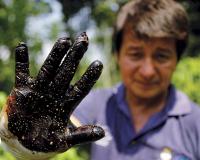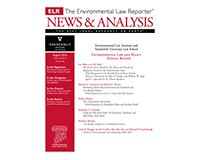
Vibrant Environment
All | Biodiversity | Climate Change and Sustainability | Environmental Justice | Governance and Rule of Law | Land Use and Natural Resources | Oceans and Coasts | Pollution Control

The legislative process is complicated. Sea-level rise adaptation is complicated. Combine the two, and a tangled mess can result as the law sorts itself out.
Few laws on the books were written with sea-level rise (or climate change, generally) in mind. As a result, policymakers, lawyers, and property owners are left to their own devices to determine how it all fits together. This round hole-square peg legal setup often requires judicial adjudication to become workable and uniform.
At the national level, the regulation of greenhouse gases under the Clean Air Act is a great example.

Something extraordinary happened last week: the Paris Agreement on climate change became a reality. Fifty-five percent of the world’s countries, and countries responsible for 55% of the world’s greenhouse gas emissions, ratified the accord. The agreement will go into effect on November 4th, far faster than many observers predicted.

Earlier this year, more than a dozen federal agencies produced a new resource document that pulls together methods that they use to evaluate environmental justice (EJ) concerns when preparing environmental analysis of proposed actions under the National Environmental Policy Act (NEPA).
This new document, Promising Practices for EJ Methodologies in NEPA Reviews (the Promising Practices report), was the product of more than three years of work by a NEPA Committee established by the federal Interagency Working Group on Environmental Justice.

At the 2016 Our Ocean Conference, nearly 20 countries announced the creation of new Marine Protected Areas (MPAs) or the expansion of existing ones. This is an important step in the right direction, but creating new MPAs will not make a significant difference if new and old MPAs are not effectively enforced. Through the release of its report, Legal Tools for Strengthening Marine Protected Area Enforcement: A Handbook for Developing Nations, the Environmental Law Institute’s (ELI’s) Ocean Program is playing its part to assist countries in ensuring that MPAs are effectively implemented and enforced, delivering positive conservation outcomes.

On August 23, 2016, the Gulf Coast Ecosystem Restoration Council (Council) released its draft Comprehensive Plan Update. This plan “is intended to provide strategic guidance” to the Council in order to “improve Council decisions…” No projects or programs are proposed in the plan. The public has until October 7, 2016 to comment on the plan. If the plan is approved, it will “supersede[] the Initial Plan approved by the Council in August 2013.”
This post highlights some of the key features of the plan, including where it fits into Gulf restoration, what’s in the plan, and what questions remain.

Imagine a map of sea-level rise in the year 2100. You know the ones—they show many of the world’s major coastal cities inundated by blue shading. With the sea predicted to rise one to two meters over that time, those maps are showing the consequences. Billions of people and trillions of dollars will be flooded out.
However, those maps only tell part of the story. Most of the world will not passively await the blue shading to come over them. Instead, local and national governments will adapt to sea-level rise. Through a suite of adaptation strategies, they will try to reduce impacts when possible and manage retreat when required.

Originally posted on ACOEL's blog.
One of the interesting questions that emerged in the strategic planning process for the Environmental Law Institute is whether ELI could offer more support in the development and/or administration of supplemental environmental projects, or “SEPs”.
Having played a role in the birthing of the original SEP framework in the early 1990s while at EPA, and through my own experience as a practitioner, I am convinced that penalty mitigation through the performance of SEPs can come as close to a win-win as is possible in the enforcement context.

I was in the 10th grade when I first heard about the ecological and human health disaster caused by petroleum extraction in Ecuador. A film festival in my hometown showed Crude, a documentary that details the impact of abandoned oil fields near Lago Agrio and the accompanying legal battle. Local populations whose livelihoods and health were allegedly harmed by careless corporate and government actions had been fighting to hold Texaco accountable for cleanup and compensation since 1993. The film, however, focused on several key characters that became involved in the case many years later. There were lawyers (Steven Donzigner and Pablo Fajardo), a corporation (Chevron, which acquired Texaco in 2001), celebrities (including Sting), and a young and charismatic Presidente (Rafael Correa of Ecuador).

At a time when environmental challenges are rising to the forefront of global conversation, it is more important than ever to think creatively about solving the world’s most pressing environmental crises. Academics are a key source of new ideas, yet all too often they talk among themselves, and their ideas are not vetted with policymakers, let alone adopted in the law and policy arena. To help bridge the gap between academic scholarship and environmental policymaking, each year, Vanderbilt University Law School (VULS) students and ELI staff select some of the best articles in the legal environmental scholarship from the previous year.

This past January, NOAA released a landmark final rule (referred to here as the Gulf Plan) establishing a permitting and regulatory framework for offshore aquaculture—fish farming—in federal waters in the Gulf of Mexico. Since the Gulf Plan is the first rule to enable aquaculture in federal waters (3-200 miles offshore), the environmental and economic outcomes are uncertain. This ruling—the product of over a decade of research and revision—has become the subject of intense criticism from both environmental organizations and proponents of offshore aquaculture. NOAA lauds the ruling as a long-overdue policy to create economic growth and meet demands for sustainable seafood. At the same time, some environmentalists predict increased pollution and fish disease, fishermen fear price drops, and potential investors think the regulation is overly complex.